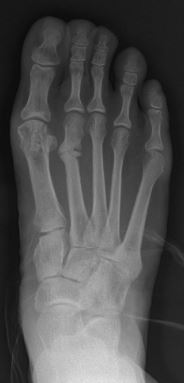
Photo from wikipedia
Stress fractures are a limitation for athletes not only in sports performance but in activities of daily living. Thus, preventing them is crucial. In female athletes, a triad of symptoms… Click to show full abstract
Stress fractures are a limitation for athletes not only in sports performance but in activities of daily living. Thus, preventing them is crucial. In female athletes, a triad of symptoms including low energy availability, functional hypothalamic amenorrhea and osteoporosis are considered risk factors for stress injuries, but biomarkers predictive of these outcomes are not available. Here, we evaluated 56 female university athletes and found that 13 had a history of stress bone injuries. Logistic regression analysis demonstrated that dysmenorrhea including amenorrhea, but not reduced food intake or body weight loss, was significantly associated with stress injuries. When we subdivided subjects into stress fracture and non-fracture groups, we found that serum levels of creatine kinase (CK) and lactic acid dehydrogenase (LDH) were significantly higher in the fracture group, while osteocalcin and uncarboxylated osteocalcin (ucOC), which are bone forming parameters, significantly decreased. Low vitamin D levels are associated with stress fractures, but serum vitamin D levels were higher in fracture compared to non-fracture subjects. We followed up 32 subjects for one year, and three exhibited new stress injuries during that period. A history of stress fracture history is significantly associated with experiencing a new stress fracture. We also found that subjects with new fracture performed significantly greater exercise activity than did non-fracture subjects. Taken together, our data indicate that increased serum CK and LDH and decreased serum osteocalcin and ucOC are biomarkers of stress injuries, and evaluating these markers along with dysmenorrhea, stress fracture history or high sports activity could predict future stress fractures in female athletes.
Journal Title: Scientific Reports
Year Published: 2018
Link to full text (if available)
Share on Social Media: Sign Up to like & get
recommendations!